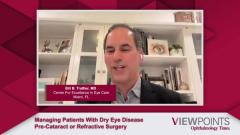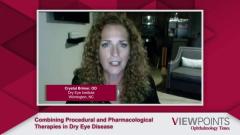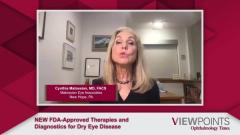
The Prevalence and Impact of Dry Eye Disease
Bill B. Trattler, MD, Crystal Brimer, OD, Cynthia Matossian, MD, FACS, and Kelly K. Nichols, OD, MPH, PhD, discuss the prevalence of dry eye disease (DED) and how it can impact the quality of life for patients.
Episodes in this series

Transcript
Bill B. Trattler, MD: Hi, and welcome to this Ophthalmology Times Viewpoints titled, Modern Approaches for Optimal Management of Dry Eye Disease. I'm Bill Trattler. I'm a refractive, corneal, and cataract surgeon at the Center for Excellence in Eye Care in Miami, Florida. I'm very lucky to be joined with three outstanding experts in dry eye. These are just rock stars in dry eye. I'm excited I get to learn so much from each of them. And let's start off with that. Dr Brimer, if you could introduce yourself and share your love for dry eye.
Crystal Brimer, OD: I do have a love for dry eye, Bill. I'm Crystal Brimer, I'm in Wilmington, North Carolina. I have a solo, private practice. It's a referral center and we only treat ocular surface disease every day, 100% of the time. I also have [the] Dry Eye Institute where we focus on the training other doctors and just equipping them to get better outcomes and trying to inspire them along the way.
Bill B. Trattler, MD: I love it. That's wonderful. Thank you so much. Thank you for being with us. Next, I have Dr Matossian. If you could introduce yourself and share your love, because I know you love dry eye; I've spent a lot of time with you. Thank you.
Cynthia Matossian, MD, FACS: I am passionate about dry eye as well. Thank you very much for inviting me to this program. I'm Cynthia Matossian. I'm the founder and past medical director of the Matossian Eye Associates. Matossian Eye is an integrated ophthalmology/optometry practice with all the different subspecialties. My area of sub specialization was refractive cataract surgery and of course, dry eye. I'm delighted to be here with all of you.
Bill B. Trattler, MD: Wonderful. Then last but certainly not least, Dr Nichols. You're passionate about dry eye. I've had a chance to work together many, many times. So, thank you for introducing yourself.
Kelly K. Nichols, OD, MPH, PhD: Thank you for allowing me to be with everyone here this evening. This is such a treat and especially to have a wonderful audience, as well. I am passionate about dry eye, always have been since before it was probably cool to like dry eye. I'm currently the dean of the University of Alabama at Birmingham School of Optometry and I've been involved in dry clinical research and translational research, as well as seeing patients for too many years that I care to say. So, it's nice to be where we are today, having this in-depth discussion about what's going on in dry eye.
Bill B. Trattler, MD: Thank you so much, Dr Nichols. I guess just to give you a quick overview; I'm super excited to be here. We're going to talk about a variety different topics on dry disease. We're going to talk about how we all diagnose dry eye, because there are all different strategies you can have, and some of the current emerging treatment options, because there are so many new things that just become approved and are about to become approved. We will also discuss other strategies, [like] how to handle the more challenging patients. I'm really excited to get started with each of you. I guess we'll start with the basics, which is, Dr. Brimer, how common do you see dry eye? Well, this is a bad question because I know you're 100% dry eye, but I guess how common is dry in general, then? And who's at increased risk for dry eye?
Crystal Brimer, OD: Well, I think if we go back 30 years, people would label it as a woman's disease because we tied it so closely with hormonal change. And yeah, that's still happening. But it seems like such a fraction now of what I see because there's nobody that's not at risk for it. I think it's almost appropriate to reverse that question, because you think about [it], our diets are completely different than they were 30 years ago. We've got more systemic disease; we have more side effects from medications. Then the biggest one, we've got way more device use than was even dreamed about 30 years ago. And you couple that with the changing of times where you've got these young kids who are growing up and basically being babysat by an iPad, which I understand. I don't have kids, but I think I can understand. But what's that going to look like in the future? It's going to be the opposite. It's going to be who is not at risk for dry.
Bill B. Trattler, MD: That's a great thought. I just love how you frame that. I don't know if maybe Dr Matossian wanted to share similar thoughts, and then we'll ask Dr Nichols as well, but Dr Matossian?
Cynthia Matossian, MD, FACS: That was a great description, Crystal, and that's how I used to approach my presurgical patients. Anybody who came in for a cataract consult, for example, I had to rule out dry eye disease before or concomitantly with evaluating their cataracts, because from your study, Bill, it showed what a high percentage of people who had never been diagnosed with dry eye were scheduled for their cataract surgery. So, like you, Crystal, I mean, we really have to almost rule out who doesn't have dry eye if such a thing exists.
Bill B. Trattler, MD: I love that. Dr. Nichols?
Kelly K. Nichols, OD, MPH, PhD: Right. I completely agree. There are so many associated factors with dry eye these days that almost everybody has one of them. It's just a matter of if they are compounding with one another and it's starting to impact the patient, and if we're asking the right questions to be able to detect it. So, I agree. It's almost like you consider everyone has dry eye until you rule it out these days.
Bill B. Trattler, MD: Dr. Nichols, that's perfect. Thank you so much. That leads us into the next very important question, which I'm actually going to turn right back to you, Dr. Nichols. Why is it important for us to recognize and treat dry eye for all of our patients?
Kelly K. Nichols, OD, MPH, PhD: I think I'll step back into the discussion a bit about how everybody [is] glued to some sort of screen or device or maybe more than one at the same time. And certainly, if you have any irritation, if you feel your eyes, you have dry eye, then that can impact your ability to be able to do your work or your activities, especially on that screen or towards the end of the day. So, I think that we're learning a lot more about the impact of dry eye on the ability to be able to work, the ability to be present at work and with dry eye and even time off from work due to dry eye and all those things. There's been research in those areas over the last several years and it's not surprising, you know, that patients are very impacted in their activities, it even can be reading, driving and other things. So, when we stop to think about who is impacted and how, you know, we might be able to help that, whether they're going on to surgery or they're having trouble functioning in their day-to-day activities, I think it's really important to be able to recognize dry eye. So, we should be asking questions all of our patients, regardless of what kind of exam it is, to try and determine if we can help them have a better outcome.
Bill B. Trattler, MD: I love that. Dr. Brimer, any additional thoughts? That was really comprehensive.
Crystal Brimer, OD: What I would say is, in being that referral center, I see the difference that it makes in their final outcome, whether we were able to implement treatment at year one versus two, two versus three, and three versus four; it's a significant difference. I mean, just today, seeing a patient with almost no glands and all she can think about is, "this could have been prevented." And so, everything that inside of me just points to the overall outcome and quality of life of this person ten, 15 years down the road, depends on when we intervene.
Bill B. Trattler, MD: I love that. Dr Matossian, you always [have] so many good thoughts. As you all know, Dr Matossian and I go to a lot of conferences together. How do you kind of approach these patients and why do you feel it's so important to address these patients with dry eye?
Cynthia Matossian, MD, FACS: You know, dry eye disease is chronic and progressive, and think of it as chronic pain. Obviously, not all dry eye patients have severe pain or moderate pain, but some do. And when somebody is in constant pain, they are grumpy and their mood swings all over the place. They snap back at their colleagues or spouses or family members, and there is depression associated with it. This is real. Studies have proven this. Therefore, just like Crystal said and like Kelly emphasized, identifying patients with dry eye disease, intervening early, and treating them as comprehensively as possible, we truly change the quality of the life of these patients, and that is a gift that many doctors have.
Transcript is AI-generated and edited for clarity and readability.
Newsletter
Don’t miss out—get Ophthalmology Times updates on the latest clinical advancements and expert interviews, straight to your inbox.



























































